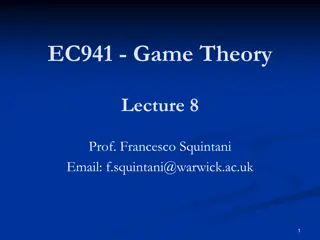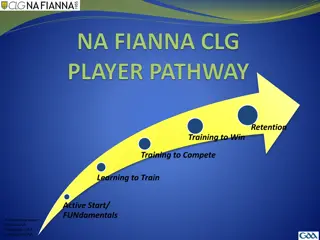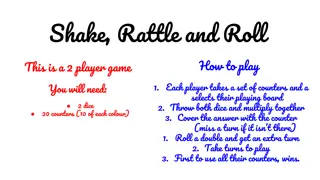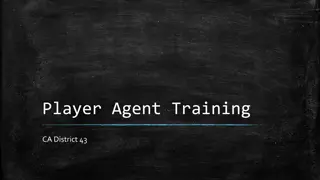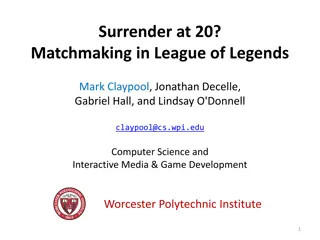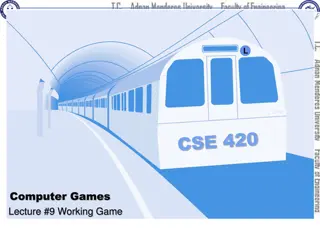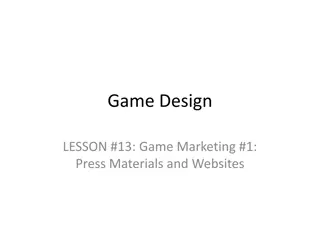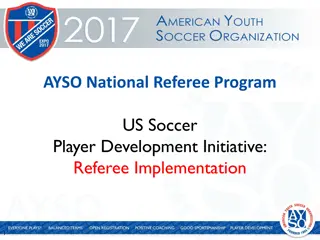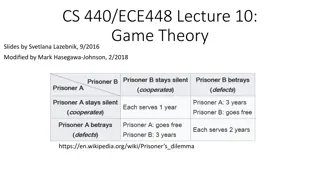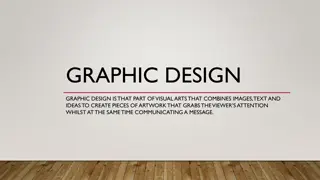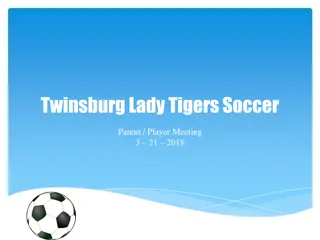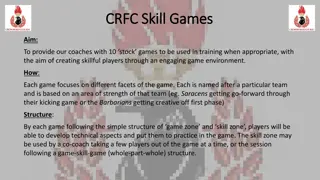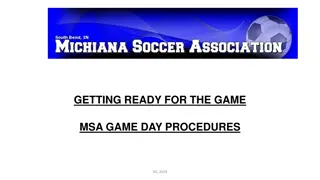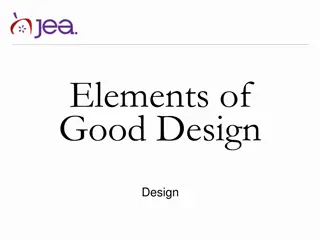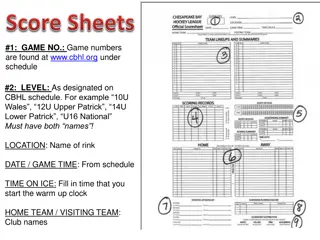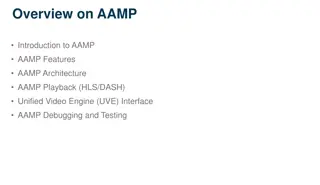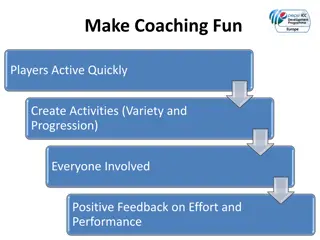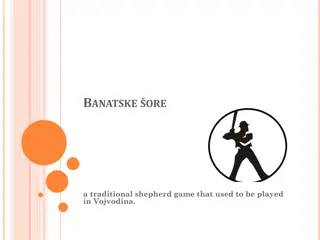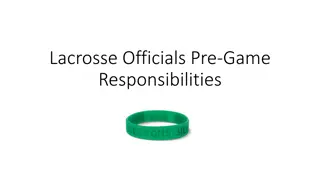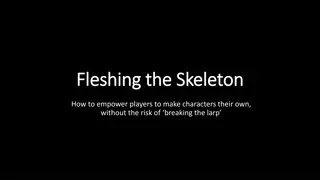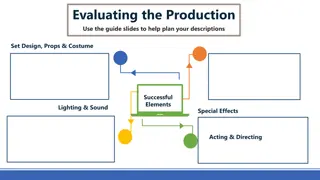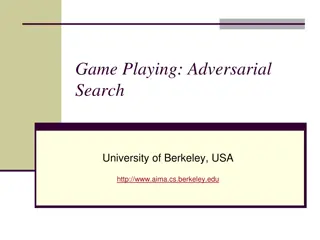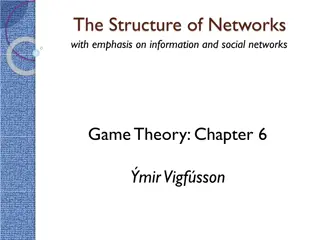Principles of Game Feel: Enhancing Player Experience through Design Elements
Explore the seven principles of game feel for enhancing player experience, including predictable results, instantaneous response, easy but deep gameplay, novelty, appealing response, organic motion, and harmony. Learn how these principles influence game design and player engagement, emphasizing factors like consistency, responsiveness, skill progression, creativity, and aesthetic appeal.
Download Presentation

Please find below an Image/Link to download the presentation.
The content on the website is provided AS IS for your information and personal use only. It may not be sold, licensed, or shared on other websites without obtaining consent from the author. Download presentation by click this link. If you encounter any issues during the download, it is possible that the publisher has removed the file from their server.
E N D
Presentation Transcript
DES315 Technical Design Methods Week 6b: Game Feel. Discuss Game Feel Reading, examples, and Project #2.
What did you choose? Go to the class Whiteboard to add your name and your two choices: What existing game do you want to discuss: one that you have played and love some aspect of the Game Feel (provide video clip URL, use the share function in YouTube to take us to the time you want us to start) What Classic Arcade Game will you enhance with Game Feel features for Project 2? Pong is supplied; anything else you will need to build before next Lab. EXAMPLE: Jason Wiser Game Feel Clip to Discuss: Spider-Man 2 Web-Swinging: https://youtu.be/4AWRR92W5gg?t=372 Classic Base Game to Modify: Space Invaders https://youtu.be/cnfwNzpoIlA
Game Feel: 7 Principles 1. Predictable Results 2. Instantaneous Response 3. Easy But Deep 4. Novelty 5. Appealing Response Chapter 17 Principles of Game Feel pp297-309 6. Organic Motion 7. Harmony
Game Feel: 7 Principles 1. Predictable Results: Consistency, without ambiguity. In good staging (spacing and timing so the player can perceive the response). Being careful about state overwhelm (if inputs are state-dependent, like a ground-check for a jump or a Tony Hawk game). 2. The game should feel like it responds /starts right away, even if the response take some time to fulfil, like turning a large vehicle. Instantaneous Response: Chapter 17 Principles of Game Feel pp297-309
Game Feel: 7 Principles 3. Low skill floor, high skill ceiling. Easy to Learn: Provide affordances through natural mappings of intended motion to controller motion, like Spider- man s pull-down to swing up being a pull down on the joystick. Utilize standard mappings where possible, to use payer s existing knowledge base. Offer AI support (auto-aim like spider-man s webs attaching to buildings and anti-magnetic forces to not swing-crash into buildings. Rubber banding mechanics to help new players stay engaged, like the blue shell in Mario Kart) Depth: A combination of elements that gives rise to player creativity, varied Heuristics (strategies towards success), and replayability. Increase control sensitivity to allow player expression. Easy But Deep: Chapter 17 Principles of Game Feel pp297-309
Game Feel: 7 Principles 4. seek ways to make the motion /response to player input fresh, either through increased content or enhanced physics simulation to add variety. Novelty: 5. Aesthetic appeal quality motion, ease-tweening, etc. Enhancements that add beauty to the experience. Appealing Response: Chapter 17 Principles of Game Feel pp297-309 6. Flowing motion, primarily on curves (like in the Disney 12 Principles Arcs ). Organic Motion: 7. Motion follows the expectations of the design ( function follows form ) a thing that looks like a car should feel like one when it moves Harmony:
Game Feel Breakouts 1: Discuss Examples In Breakout Rooms, discuss your game example video clips. Each person in the room add your game name, Game Feel name, and video clip URL to the Breakout room chat. Discuss each: what you experienced playing it, what you liked about it Return. What was an examples, shared by a classmate, that you found particularly interesting?
Game Feel 7: UI / HUD How can a HUD feel dynamic and responsive?
Game Feel Breakouts 2: Brainstorming In Breakout Rooms, brainstorm homwework ideas: discuss your Base Game and Game Feel ideas. Each person in the room add your Base Game choice to the Breakout room chat. Discuss each: what are some ideas you have for Game feel enhancements? What are some wacky, unexpected options? Return. What was an example that was discussed that you found particularly interesting?
Project 2: Unity Using the provided Pong Unity Package (or one of the others): 1. Download and import the package into a new Unity 3D project. 2. Crete a new Scene, disable the MainCamera and Light. 3. Drag the new FullPongGame Prefab into a Scene. 4. Hit Play! [W][S] to move Player 1 paddle (left) [upArrow][downArrow] to move Player 2 paddle (right) Don t like the motion? Work on the responsiveness by changing the PongPlayer script. For example try changing the speed curve of the paddles so they react more quickly. You can change whatever you want! Consider Changing Unity Game Look and Feel (see course website) Universal Render Pipeline Custom Shaders and Shader Graphs Post processing
Project 2: What Assets can I use? For all projects in this course I prefer you make all the work yourself, but for project #2 if getting help on one feature enables you to go much more deeply into others, that is a good prototyping choice. DigiPen DES classes have some leeway. In the Freshman and Sophomore GAM courses we don't allow the use of any outside art assets, except for pre- approved fonts. We can decide to avoid all 3rd-party assets or you can model your Project #2 policy after some of the other GAM courses: 3rd-party art assets may be used under the following conditions: The assets must be free or licensed for commercial use, not just for educational use. This is safest because DigiPen is a for-profit school. The assets must be credited, using the name and URL of each asset. To get the URL for Unity Store assets, go through the web store, rather than the client app. The license must be approved by the instructor. You could pre-approve certain sources, such as the Unity Asset Store, and disallow any other sources, or allow approval on a case- by-case basis. This decision is up to you. Free or charged? Free assets are fine but what about paid assets? No paid assets over $5
WEEKEND To-do List: Due Saturday: Submit Game Feel Mini-Paper (based on your sample clip, due Mindight Saturday) Due Monday: Submit your Project 2 Spec Doc (due Midnight Monday) Import a package (or create from scratch) a base arcade game into a new, solo Unity project. Create at least one example of Game Feel in this project. Create a WebGL build to share in class. Please contact the teacher on Teams Chat time to help with anything in Design, Unity, or GitHub! HAVE A GREAT WEEK! JasonWiserArt@gmail.com


